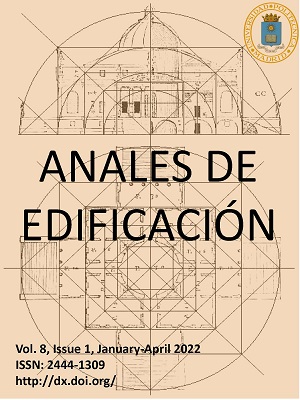Una contribución a la economía circular: cenizas volantes de incineración de residuos sólidos urbanos para producir aglutinantes ecológicos = A contribution to the circular economy: municipal solid waste incineration fly ash to produce eco-friendly binders
DOI:
https://doi.org/10.20868/ade.2022.5021Palabras clave:
Cenizas volantes de RSU, Ligantes ecológicos, Composición química, Análisis mineralógicos, Análisis morfológicos, MSWI fly ash, Eco-friendly binders, Chemical composition, Mineralogical analyses, Morphological analysesResumen
Los residuos sólidos urbanos son uno de los problemas medioambientales más acuciantes a los que se enfrenta el mundo. Hoy en día, la incineración se considera la tecnología más eficaz para tratarlos. Sin embargo, tras el proceso de incineración, cerca del 25% de la masa total inicial de residuos son cenizas, que deben eliminarse en vertederos. Las tendencias recientes sugieren que es posible seguir avanzando en la eficiencia de los recursos convirtiendo los residuos en un recurso y cerrando así el ciclo en una economía circular. Las cenizas volantes pueden utilizarse como sustituto de los recursos naturales en la construcción, como áridos o en la fabricación de nuevos materiales. En particular, estas cenizas volantes contienen elementos como Ca, Si y Al, que permiten su utilización como materia prima para la fabricación de ligantes. En el presente trabajo, se presentarán los resultados obtenidos a partir de la caracterización fisicoquímica de las cenizas volantes. El objetivo de la investigación es explorar la viabilidad del uso de estas cenizas volantes como materia prima en la fabricación de ligantes ecológicos.
Abstract
Municipal solid waste is one of the most pressing environmental problems the world faces. Nowadays, incineration is considered to be the most effective technology for treating it. However, after the incineration process, close to 25% of the initial total mass of waste is ash, which has to be placed of in landfills. Recent trends suggest that further progress in resource efficiency is possible by turning waste into a resource and thus closing the loop in a circular economy. Fly ash can be utilized as a substitute for natural resources in construction, as in aggregates or in the manufacture of new materials. In particular, these fly ashes contain elements such as Ca, Si and Al, which make it possible for them to be used as a raw material to manufacture binders. In the present work, the results obtained from the physicochemical characterization of fly ashes will be presented. The research aims to explore the feasibility of using this fly ash as raw material in the manufacture of eco-friendly binders.
Descargas
Referencias
P.H. Brunner, H. Rechberger, Waste to energy – key element for sustainable waste management, Waste Manage. 37 (2015) 3–12. https://doi.org/10.1016/j.
W.S. Chen, F.C. Chang, Y.H. Shen, M.S. Tsai, C.H. Ko, Removal of chloride from MSWI fly ash, J. Hazard. Mater. 237 (2012) 116–120. https://doi.org/10.1016/j.jhazmat.2012.08.010.
DIRECTIVE OF THE EUROPEAN PARLIAMENT AND OF THE COUNCIL amending Directives 2008/98/EC on waste, 94/62/EC on packaging and packaging waste, 1999/31/EC on the landfill of waste, 2000/53/EC on end-of-life vehicles, 2006/66/EC on batteries and accumulators and waste batteries and accumulators, and 2012/19/EU on waste electrical and electronic equipment/* COM/2014/0397 final - 2014/0201 (COD) */. https://eur-lex.europa.eu/legal-content/EN/TXT/? uri=CELEX:52014PC0397.
European Commission, 2020. Study on the EU’s list of Critical Raw Materials. file:///C:/Users/iabmagoc/AppData/Local/Temp/CRM%20list%202020_Final%20Report.pdf.
S. Goñi, A. Guerrero, A. Macías, M.P. Lorenzo, Materias primas alternativas para la fabricación de cementos más ecoeficientes de baja energía, Revista ALCONPAT. 1, (2011) 17–29. https://doi.org/10.21041/ra.v1i1.3.
Guerrero, E. Fernandez, A. Macias, S. Goñi, Hydrothermal treatment of fly ash from municipal solid waste incineration, in Waste Materials in Construction WASCON 2000, Elsevier Science Ltd.
D. Hoornweg, P. Bhada-Tata, What a Waste: A Global Review of Solid Waste Managament, Urbal Development Series Knowledge Papers. (2012) 151–198. http://hdl.handle.net/10986/17388.
Y. Hu, P. Zhang, D. Chen, B. Zhou, J. Li, X. Li, Hydrothermal treatment of municipal solid waste incineration fly ash for dioxin decomposition, J. Hazard. Mater. 207 (2012) 79-85. https://doi.org/10.1016/j.jhazmat.2011.05.068.
Z. Phua, A. Giannis, Z.L. Dong, G. Lisak, W.J. Ng, Characteristics of incineration ash for sustainable treatment and reutilization, Environ. Sci. Pollut. 26 (2019) 16974–16997. https://doi.org/10.1007/s.11356-019-05217-8.
Reijnders, The cement industry as a scavenger in industrial ecology and the management of hazardous substances, J. Ind. Ecol. 11 (2007) 15–25. https://doi.org/10.1162/jiec.2007.997.
L.M. Sarmiento, K.A. Clavier, J.M. Paris, C.C. Ferraro, T.G. Townsend, Critical examination of recycled municipal solid waste incineration ash as a mineral source for Portland cement manufacture-A case study, Resour Conserv Recycl. 148 (2019) 1–10. https://doi.org/10.1016/j.resconrec.2019.05.002
R.V. Silva, J. Brito, C.J. Lynn, R.K. Dhir, Environmental impacts of the use of bottom ashes from municipal solid waste incineration: A review, Resour Conserv Recycl. 40 (2019) 23–35. https://doi.org/10.1016/j.resconrec.2018.09.011.
Y. Xu, Y. Fu, W. Xia, D. Zhang, D. An, G. Quian, Municipal solid waste incineration (MSWI) fly ash washing pretreatment by biochemical effluent of landfill leachate substitute for water, Environ. Technol. 39 (15) (2017) 1949–1954. https://doi.org/10.1080/09593330.2017.1345985.
K.H. Yang, Y.B. Jung, M.S. Cho, S.H. Tae, Effect of supplementary cementitious materials on reduction of CO2 emissions from concrete, J. Clean. Prod. 103 (2015) 774-783. http://dx.doi.org/10.1016/j.jclepro.2014.03.018.
X. Yu, J. Jiang, Phosphate microbial mineralization consolidation of waste incineration fly ash and removal of lead ions, Ecotoxicol. Environ. Saf. 191 (2020) 110224, https://doi.org/10.1016/j.ecoenv.2020.110224.
Descargas
Publicado
Número
Sección
Licencia
1. Los autores conservan los derechos de autor y garantizan a la revista el derecho de una Licencia Creative Commons Atribución - Nocomercial 4.0 Internacional que permite a otros compartir el trabajo con un reconocimiento de la autoría y uso no comercial.
2. Los autores pueden establecer por separado acuerdos adicionales para la distribución no exclusiva de la versión de la obra publicada en la revista (por ejemplo, situarlo en un repositorio institucional o publicarlo en un libro).
Salvo indicación contraria, todos los contenidos de la edición electrónica se distribuyen bajo una licencia de uso y distribución “Creative Commons"












